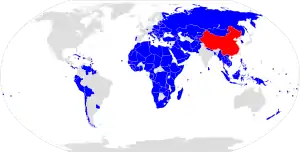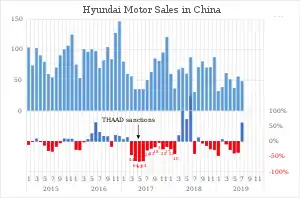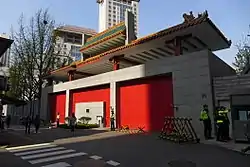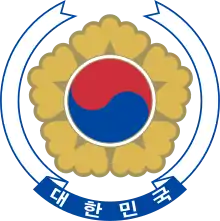China–South Korea relations
China–South Korea relations largely refers to the diplomatic relations between the People's Republic of China (China) and the Republic of Korea (South Korea), which were formally established in the 1990s. Before then, the government in mainland China recognized only the Democratic People's Republic of Korea (North Korea) while South Korea in turn recognized only the Republic of China (Taiwan). In recent years, China and South Korea have endeavored to boost their strategic and cooperative partnership in numerous sectors, as well as promoting a high level relationship.[1] Trade, tourism and multiculturalism, specifically, have been the most important factors of strengthening two neighbouring countries cooperative partnership.
 | |
China |
South Korea |
|---|---|
| Diplomatic mission | |
| Chinese Embassy, Seoul | Korean Embassy, Beijing |
| Envoy | |
| Ambassador Xing Haiming | Ambassador Jang Ha-sung |
Historically, both nations are bound together by a shared history, an overlap in cuisine,[note 1] religion, a common language script[note 2] and legal systems, and kinship ties that reach back thousands of years, especially during the Song and Ming Dynasty, where it shared a close trade and diplomatic relationship with Goryeo and the Joseon Dynasty respectively. The Ming and Joseon emerged after the invasion of the Mongols and shared close Confucian ideals in its society. Furthermore, the Ming had assisted Joseon during Toyotomi Hideyoshi's invasion of Korea, in which the Wanli Emperor sent a total of 221,500 troops.[2] Joseon had also used Classical Chinese as a common script alongside Korean, and its central government was modelled after the Chinese system.[3][4]
Contemporary relations between China and South Korea are characterized by extensive trading and economic relations. China is by far South Korea's largest trading partner, with China importing goods worth $160 billion from South Korea in 2018, which comprised 26% of South Korea's total exports. 21% of South Korea's imports also came from China, worth $107 billion in 2018.[5] In 2015, China and South Korea signed the bilateral China–South Korea Free Trade Agreement which aimed to boost annual bilateral trade to over $300 billion, while lifting both countries' GDP.[6] In November 2020, China and South Korea, along with 13 other Asia-Pacific nations, signed the Regional Comprehensive Economic Partnership, the largest free-trade agreement in history which covers 30% of the world's population and economic output.[7] While the RCEP is considered a major step forward to coalesce the economies of other fellow Asian countries, China, South Korea and Japan are also engaged in long-running negotiations for a trilateral free-trade agreement which would further integrate their economies, including the free movement of goods, capital, services, and labor.[8]
Occasionally, political disputes still occur between the modern states of South Korea and China.[9] In 2016, relations were affected when South Korea agreed to deploy the THAAD, an American anti-ballistic missile defense system, allegedly meant for North Korea, but a move that China strongly opposed. China imposed an unofficial boycott on South Korea in an attempt to stop them from deploying the missile system.[10] However, at the end of October 2017, the two countries ended their diplomatic dispute and have been working swiftly to get their relationship back on track since, strengthening exchanges and cooperation between each other, creating harmony of interests, and agreed to resume exchanges and cooperation in all areas. All economic and cultural bans from China towards South Korea were also lifted as a result, with political and security cooperation, businesses and cultural exchanges between the two countries getting back to healthy and positive state.[11][12][13][14]
Upon resumption of relationship, China and South Korea have been organizing presidential and governmental visits, working together on the Korean Peninsula, assisting with the development of other countries, and cooperating in numerous areas.[15][16][17][18] Furthermore, in light of the increasing tensions between China and the United States which had intensified during the Trump administration, South Korean president Moon Jae-in has stated that his country will stay neutral, and that he is willing to boost positive ties and promote high-level exchanges with China, as the country considers such relations 'equally important'.[19]
History of relations
Korean War
The newly established People's Republic of China participated in the Korean War between 1950 and 1953, sending the People's Volunteer Army to fight alongside Soviet Union against United States and United Nations troops in October 1950. It successfully drove the UN forces out of North Korea, but its own offensive into the South itself was repelled. The participation of the PVA strained relations between South Korea and China. The Korean War concluded in July 1953, resulting in the establishment of the Korean Demilitarized Zone, and the eventual withdrawal of Chinese forces from the Korean Peninsula. US troops though have remained in South Korea to this day.
Cold War
Throughout the Cold War, there were no official relations between the PRC and ROK. The PRC maintained close relations with North Korea, and South Korea maintained diplomatic relations with the ROC based in Taipei. This hindered trade between Seoul and Beijing, because South Korea was unable to protect its citizens and business interests in China without some form of international agreements. Beijing's economic needs involving South Korea were initially eclipsed by those of Moscow.
Relations under Park and Chun (1961–1988)
President Park Chung-hee initiated and President Chun Doo-hwan advanced a policy of establishing relations with China and the Soviet Union, and attempting to improve those with North Korea. China and the USSR had significant sway in determining the future of the Korean Peninsula. Good relations with old allies of North Korea were therefore integral to the Nordpolitik policy.
Seoul's official contact with Beijing started by the landing of a hijacked CAAC Flight 296 in May 1983. China sent a delegation of thirty-three officials to Seoul to negotiate its return. This marked the beginning of a series of casual exchanges of citizens. For example, in March 1984, a South Korean tennis team visited Kunming for a Davis Cup match with a Chinese team. In April 1984, a thirty-four-member Chinese basketball team arrived in Seoul to participate in the Eighth Asian Junior Basketball Championships. Some Chinese officials reportedly paid quiet visits to South Korea to inspect its industries, while South Korean officials visited China to attend a range of international conferences.
Late 1980s
Active South Korean-Chinese individual contacts have been encouraged. Academics, journalists, and particularly families divided between South Korea and China were able to exchange visits freely in the late 1980s. Significant numbers of citizens of each country reside in the other. As of 2009, more than 600,000 PRC citizens reside in South Korea, of whom 70% are ethnic Koreans from the Yanbian Korean Autonomous Prefecture in China's Jilin Province and other parts of China, while roughly 560,000 South Korean citizens lived in China.[20][21]
However, during this period significant barriers to strong trade and relations persisted. The absence of any protections granted by official relations had still remained. Beijing has been politically closer to Pyongyang, and relations with North Korea remained tense and distrustful.
After the Tiananmen Square protests, Pyongyang publicly supported Beijing's actions. Seoul, on the other hand, did not make any major comments or condemnation of the event.
Post Cold War and Reform and Opening Up
Trade between the two countries continued to increase nonetheless, especially after the PRC's reform and opening up. Furthermore, China has attempted to mediate between North Korea and the US; between North Korea and Japan; and also initiated and promoted tripartite talks—between Pyongyang, Seoul, and Washington.[22]
South Korea had been an ally of the Republic of China. But in 1992 diplomatic ties between Seoul and Taipei were nevertheless severed. On August 24, 1992 formal diplomatic relations were established between Seoul and Beijing. By 2004 China had become South Korea's leading trading partner.[23]
After the KORUS FTA (United States-Korea Free Trade Agreement) was finalized on 30 June 2007, the Chinese government immediately began seeking an FTA agreement with South Korea.[24] The China-Republic of Korea Free Trade Agreement was finalized on December 20, 2015. Tariffs on 958 products including medical equipment, transformers, etc. were eliminated. On 1 January 2016, tariffs were eliminated on 5,779 products for 2 years. Also, in 10 years it is estimated that the Chinese tariffs will gradually go down and be eliminated on 5,846 products.[25] South Korea has been running a trade surplus with China, which hit a record US$32.5 billion in 2009 and total trade between the two nations surpassed US$300 billion in 2014.[26][23]
On 29 November 2010, a United States diplomatic cables leak mentioned two unknown Chinese officials telling then Vice-Foreign Minister Chun Yung-woo that the PRC would favor a Korea reunified under the South's government, as long as it was not hostile to China.[27]

It was announced on 10 January 2011 that the Ministry of Foreign Affairs and Trade (MOFAT) established two teams of China experts and language specialists under its department handling Chinese affairs in an effort to strengthen diplomacy.[28] An analytical team will report on political, economic and foreign affairs developments in China, and a monitoring team consisting of seven language specialists will report on public sentiment in China. The Institute of Foreign Affairs and National Security (IFANS), a think-tank affiliated to MOFAT, also launched a centre dedicated to China affairs, which will act as a hub to collate research on China undertaken in Korea.[29]
The Park-Xi summit in 2013 showed promise of warming relations, but this quickly chilled after China extended their Air Defense Identification Zone (East China Sea) over South Korean territory.[30] Despite this, in July 2014, Xi visited South Korea before its traditional ally North Korea, and in their talks, both leaders affirmed their support for a nuclear-free Korean peninsula and the ongoing free trade agreement negotiations.[31] Both leaders also expressed their concerns over Japanese Prime Minister Shinzō Abe's reinterpretation of Article 9 of the Japanese Constitution.
Political issues
Allegations of illegal fishing
In October 2016, South Korea lodged a formal complaint with Beijing accusing Chinese fishing boats of ramming and sinking a South Korean coast guard vessel. The incident occurred on 7 October when South Korean coast guard officers were trying to stop about 40 Chinese fishing boats from suspected illegal fishing off South Korea's west coast.[32] The incidents of illegal Chinese entry continued and on 1 November 2016, South Korea ships opened fire on illegal Chinese boats. No casualties were reported.[33]
Background

In late 2016, the United States and South Korea jointly announced the deployment of the Terminal High-Altitude Area Defense (THAAD), allegedly in response to nuclear and missile threats by North Korea.[34] The U.S. states that the deployment of the THAAD is “purely a defensive measure… only aimed at North Korea” and has no intention to threaten China's security interests. But China has continuously expressed its opposition over South Korea and U.S.’s decision because of its concern that the deployment of THAAD might be a measure by the U.S. to contain China.[35]
“It was China, not North Korea, that was the most uncomfortable with the idea of deploying THAAD in South Korea,” said Yang Uk, a military expert at the Korea Defense and Security Forum. Beijing opposed THAAD and its powerful radar that can see deeply into Chinese territory, saying it upsets the regional security balance.
Opposition from China
Stating that the THAAD will undermine China's own nuclear deterrent capability, China’s Ambassador Qiu Guohong warned that the deployment of THAAD could “destroy” the China–South Korea ties in an instant, whereas the spokesperson of the president of South Korea warned China that deploying the THAAD is a “matter we will decide upon according to our own security and national interests." [37]
For aims of a détente (a relaxation of tension), China and South Korea held a summit in Hangzhou, eastern China, on Sept. 5, 2016 with each party's leaders Xi Jinping and Park Geun-Hye to discuss the issue of THAAD. During the summit, Park reemphasized that the THAAD deployment is only to be aimed against North Korea and that there should be no reason for China's security interest to be concerned. However, Xi reiterated China's firm stance against the deployment of THAAD stating that it could “intensify disputes". Yet, the two countries still emphasized the long history of their relationship and agreed that a stable and healthy bilateral relationship will benefit both countries.[38]
Effect of THAAD on South Korea's economy

With South Korea's decision in 2017 to accept the deployment of THAAD in the country, although China's government shied away from formal sanctions and measures, it has urged its citizens through official media to express their displeasure and ill will at South Korea over the move.[39] Chinese citizens were allowed to gather to protest. The news media has reported of citizen boycotts of South Korean products like Hyundai cars, of South Korean goods being removed from supermarket shelves, and tourists and travel companies canceling trips to South Korea.[40]
South Korean conglomerate Lotte Group became a particular focus. Lotte had agreed to an exchange of land, a golf course in Seongju, with the South Korean government that will be used for the THAAD deployment. In addition to a consumer boycott of Lotte stores in China, municipal authorities suddenly discovered that Lotte stores and factories to be in contravention of fire safety regulations and other local ordinances which has resulted in the closure of 75 out of 99 Lotte supermarkets.[40][41][42]
March sales of Hyundai and its sister brand Kia Motors in China plunged 52 per cent from a year earlier to 72,000 vehicles, the lowest level since 2014.[40] Chinese tourism also dropped 39.4% (compared to March 2016) in March.[43]
Culture
Both Chinese and Korean cultures, singers, actors and dancers are popular with both countries' youth because of the development of the internet and export of cultural content, such as Chinese artists being in K-pop, most notably Exo, Aespa, NCT, Kris Wu, Handong from Dreamcatcher, as well as Yiren from Everglow. After the THAAD dispute took place, a "Korea limitation order" (Chinese: 限韩令) was placed upon Hallyu. In China, Hallyu cultural events were canceled, Korean actors had to quit from their works and limited Korean media could be exported to China. The ban was lifted soon after, and relations were restored.[11]
BTS Korean War controversy
On 13 October 2020, RM, a member of South Korean boy group BTS, made a speech about the Korean War, where he told South Korea shared "history of pains" by mentioning the United States, with no mention for China, who was involved in the war and had suffered numerous casualties. Chinese media lashed out at RM for what they perceived as bias and insensitivity to China's role on the other side of the conflict, and some Chinese netizens have called to boycott Korean popular culture.[44][45]
Historical controversies
The historical claims surrounding Goguryeo and its related kingdoms has created some tension between the ROK and the PRC, who claim that the kingdom is both Korean and Chinese respectively.[46] The Chinese government's Northeast Project between 2002 and 2007, a research project into Goguryeo and other various Korean kingdoms, including Gojoseon, Buyeo and Balhae, states that they were Chinese tributary states. This sparked some controversy in South Korea, especially among Korean ultranationalists, when the project was publicized in 2004.
On 14 October 2020, South Korean media outlet JTBC claimed that a number of American schools' textbooks have taught Korea as a core part of China and only gained independence from China in 1876, criticizing the latter as trying to "manipulate history" and that American schools were complicit on neglecting its education.[48] JTBC crew also claimed that they discovered Chinese social medias such as Baidu who also worked to "distort" Korean history and sinicize many Korean figures such as Kim Gu and Yun Dong-ju – who was born in Jilin Province – or instead referring to the peninsula as "Joseon" or "Chosun" (the country's old name) rather than "Korea".[48] However, this is despite the fact that many organizations in the country also uses the term "Chosun", such as South Korea's oldest daily newspaper the The Chosun Ilbo.[49]
Joint stance on Japan
Due to the Empire of Japan and atrocities committed by the Imperial Japanese Army on both the Koreans and Chinese, from women who supplied sex during WWII(known as comfort women) and the Japanese colonization of Korea to the Nanjing Massacre and Unit 731, Korea (both North and South) and China are unified in their stance against Japan and insistence on greater reparations for Japan wartime atrocities.
1910-1945 provisional ROK government
When the Korean peninsula was colonized by Imperial Japan, the provisional government of the ROK in exile in Shanghai received significant amounts of financial support from China.
Japanese war crimes
Both the governments of China and South Korea take a firm stand on issues in relation to Japanese war crimes. Korea had been under Japanese rule after the collapse of the Joseon Dynasty in 1910. During the Second Sino-Japanese War, Japan had invaded and occupied eastern China as well.
During World War II, the Imperial Japanese Army perpetrated many war crimes against both Chinese and Koreans. This has caused both to oppose the Japanese government's stand on war crimes committed during the war. Issues where both the Chinese and South Korean governments stand together include the controversial visits of Japanese politicians to the Yasukuni Shrine, the Japanese history textbook controversies, and comfort women.
An Jung-geun
In 2014, a memorial dedicated to Korean assassin An Jung-geun was opened in the Chinese city of Harbin, where he assassinated Japanese Prime Minister Itō Hirobumi in 1909, during the Japanese rule over Korea. The Japanese government protested the move, referring to An as a "terrorist".[50]
Public opinion
Survey published in 2019 by the American think tank Pew Research Center claimed that 63% of South Koreans had an "unfavourable view" of China, with 34% having a "favorable view".[51]
See also
- 2010 Eocheong boat collision incident
- 2011 Gyeongryeolbi island fishing incident
- 2011 Incheon fishing incident
- China-Japan-South Korea trilateral meeting, 2008
- Nordpolitik
- East Asian Games
- People's Republic of China-North Korea relations
- Republic of China–South Korea relations
Notes
- Korean Chinese cuisine
- The traditional writing script of Korea, Hanja, was based on Traditional Chinese characters, and was used as early as 400 BCE up until the introduction of Hangul where it is now used concurrently.
References
- http://www.korea.net/news.do?mode=detail&guid=47084
- Lee, Kenneth (January 1, 1997). Korea and East Asia: The Story of a Phoenix. Greenwood Publishing Group. p. 108. ISBN 9780275958237. Retrieved March 26, 2015. "Thus the Korea–Japan War of 1592–1598 came to a conclusion, with the Japanese totally defeated and in full-scale retreat. The Korean victory did not come easily."
- Lee, Soyoung (October 2004). "Yangban: The Cultural Life of the Joseon Literati". Metropolitan Museum of Art. Retrieved 11 January 2021.
- Lee, Ki-baik (1984). A New History of Korea. Translated by Wagner, Edward Willett; Schultz, Edward J. Harvard University Press.
- "South Korea (KOR) Exports, Imports and Trade Partners". Retrieved 24 January 2021.
- "It's Official: China, South Korea Sign Free Trade Agreement". The Diplomat. June 2, 2015.
- "RCEP: Asia-Pacific countries form world's largest trading bloc". BBC. November 16, 2020.
- "Can China, Japan and South Korea follow RCEP with their own free-trade deal?". South China Morning Post. November 28, 2020.
- https://www.brookings.edu/wp-content/uploads/2020/07/FP_20200606_china_south_korea_pak_v2.pdf
- "Why China's economic jabs at South Korea are self-defeating". South China Morning Post. 2017-04-02. Retrieved 2019-07-29.
- "South Korea, China say to mend ties after THAAD standoff". Channel NewsAsia.
- "China, South Korea agree to mend ties after THAAD standoff". Reuters. 2017.
- CNN, Ben Westcott and Lauren Suk. "China, South Korea end year-long diplomatic feud over missile system". CNN.
- AP, Hyung-Jin Kim /. "China, South Korea Ease Tensions Over U.S. Missile Defense". Time.
- Jennings, Ralph. "South Korea Vying with China as New Benefactor for Philippines". VOA.
- Diplomat, Charlotte Gao, The. "South Korean Foreign Minister to Visit Beijing After China Envoy's North Korea Visit". The Diplomat.
- "South Korean foreign minister to visit China to arrange presidential trip- Nikkei Asian Review". Nikkei Asian Review. Archived from the original on 2017-11-21. Retrieved 2017-11-21.
- "Seoul to closely cooperate with China, Japan to tackle North Korea issue". UPI.
- Park, Chan-kyong (18 January 2021). "Moon Jae-in says South Korea will not take sides in US-China rivalry, focuses on Xi Jinping's visit". scmp.com. South China Morning Post. Retrieved 30 January 2021.
The two leaders vowed to boost people-to-people and economic exchanges, cooperate in the fight against Covid-19 and work towards resolving the stand-off over North Korea’s nuclear programme. Moon asked for China to take a “constructive role” on North Korea, while Xi expressed support for both inter-Korean dialogue and talks between the United States and Pyongyang.
- Kim, Kyoungwha (2009-01-09), "South Koreans Quit China as Yuan's Gain Raises Cost of Living", Bloomberg L.P., retrieved 2009-05-04
- "More Than 1 Million Foreigners Live in Korea", Chosun Ilbo, 2009-08-06, retrieved 2009-10-18
- Zhao, Quansheng. "China and the Korean Peace Process." In the Korean Peace Processand the Four Powers. Burlington: Ashgate, 2003.
- Zhu, Zhiqun (October 2016). "Comrades in Broken Arms: Shifting Chinese Policies Toward North Korea: Comrades in Broken Arms". Asian Politics & Policy. 8 (4): 575–592. doi:10.1111/aspp.12287.
- "ROK’s Yonhap: Exports have been Remarkable, but can S. Korea Sustain Momentum?" Yonhap, October 21, 2004, FBIS, KPP20041021000040.
- "China-Korea FTA." China FTA Network. Ministry of Commerce of the People's Republic of China, n.d. Web.
- "S Korea posts record-high trade surplus in 2009". 2010-01-14.
- Tisdall, Simon. "Wikileaks Cables Reveal China 'ready to Abandon North Korea'" The Guardian, 29 Nov. 2010. Web. 7 Dec. 2010. <https://www.theguardian.com/world/2010/nov/29/wikileaks-cables-china-reunified-korea>
- Moore, Thomas G. "China's International Relations: The Economic Dimension." In The International Relations of Northeast Asia. Lanham, Md.: Rowman and Littlefield Publishers, Inc., 2004, 101.
- "Korea strengthens China analyst team". 2011-01-12. Archived from the original on 2011-07-13.
- Miller, J. Berkshire (30 November 2013). "Is the China-South Korea Honeymoon Over?". thediplomat.com. The Diplomat. Retrieved 30 November 2013.
- Perlez, Jane (2014-07-03). "China and South Korea Affirm Antinuclear Goals". The New York Times.
- https://www.washingtonpost.com/world/asia_pacific/seoul-protests-to-beijing-over-sinking-of-coast-guard-vessel/2016/10/10/4654fa68-8eb8-11e6-bc00-1a9756d4111b_story.html
- "South Korea fired on Chinese boats illegally in its waters".
- Sherman, Paul Haenle and Anne. "The Real Answer to China's THAAD Dilemma." The Diplomat. The Diplomat, 12 Sept. 2016.
- "Background Briefing with a Senior Administration Official on National Security Advisor Susan Rice's Visit to China July 26, 2016." Beijing/China. Embassy of the United States, n.d. Web.
- "'No Nukes, No THAAD': South Korean town calls for missile defense..." Reuters. 2018-07-06. Retrieved 2019-05-28.
- Tiezzi, Shannon. "China Warns THAAD Deployment Could Destroy South Korea Ties 'in an Instant'" The Diplomat. The Diplomat, 25 Feb. 2016.
- Song, Sang-Ho. "Yonhap News Agency." (6th LD) Park, Xi Reconfirm Differences pt. 2016.
- McDonell, Stephen (13 March 2017). "China fuels anger over Seoul's missile move". BBC News.
- "South Korea's Hyundai, Kia sales halve in China amid diplomatic spat over THAAD". South China Morning Post. 5 April 2017.
- Mullen, Jethro; Han, Sol (7 March 2017). "One company is bearing the brunt of China's anger over U.S. missile system". CNN Money. Retrieved 14 March 2017.
- Hernandez, Javier; Guo, Owen; McMorrow, Ryan (9 March 2017). "South Korean Stores Feel China's Wrath as U.S. Missile System Is Deployed". The New York Times. Retrieved 14 March 2017.
- "3월 중국인 관광객 39% 줄어… '사드 보복' 영향" [Chinese tourists decrease by 39% in March ... Impact of 'THAAD Revenge']. Yonhapnews. April 5, 2017.
- https://www.thejakartapost.com/life/2020/10/13/chinese-fans-upset-by-bts-korean-war-remark-report.html
- https://mothership.sg/2020/10/bts-china-korean-war/
- 02Gries.pmd
- http://mnews.jtbc.joins.com/News/Article.aspx?news_id=NB11973829
- Frank, Rüdiger; Hoare, Jim; Köllner, Patrick; Pares, Susan (2009). Korea Yearbook (2009): Politics, Economy and Society. Leiden: BRILL. p. 207. ISBN 9789004180192.
- "Japan protest over Korean assassin Ahn Jung-geun memorial in China". BBC. January 20, 2014. Retrieved August 3, 2016.
- "People around the globe are divided in their opinions of China". Pew Research Center. 30 September 2019.


.svg.png.webp)
